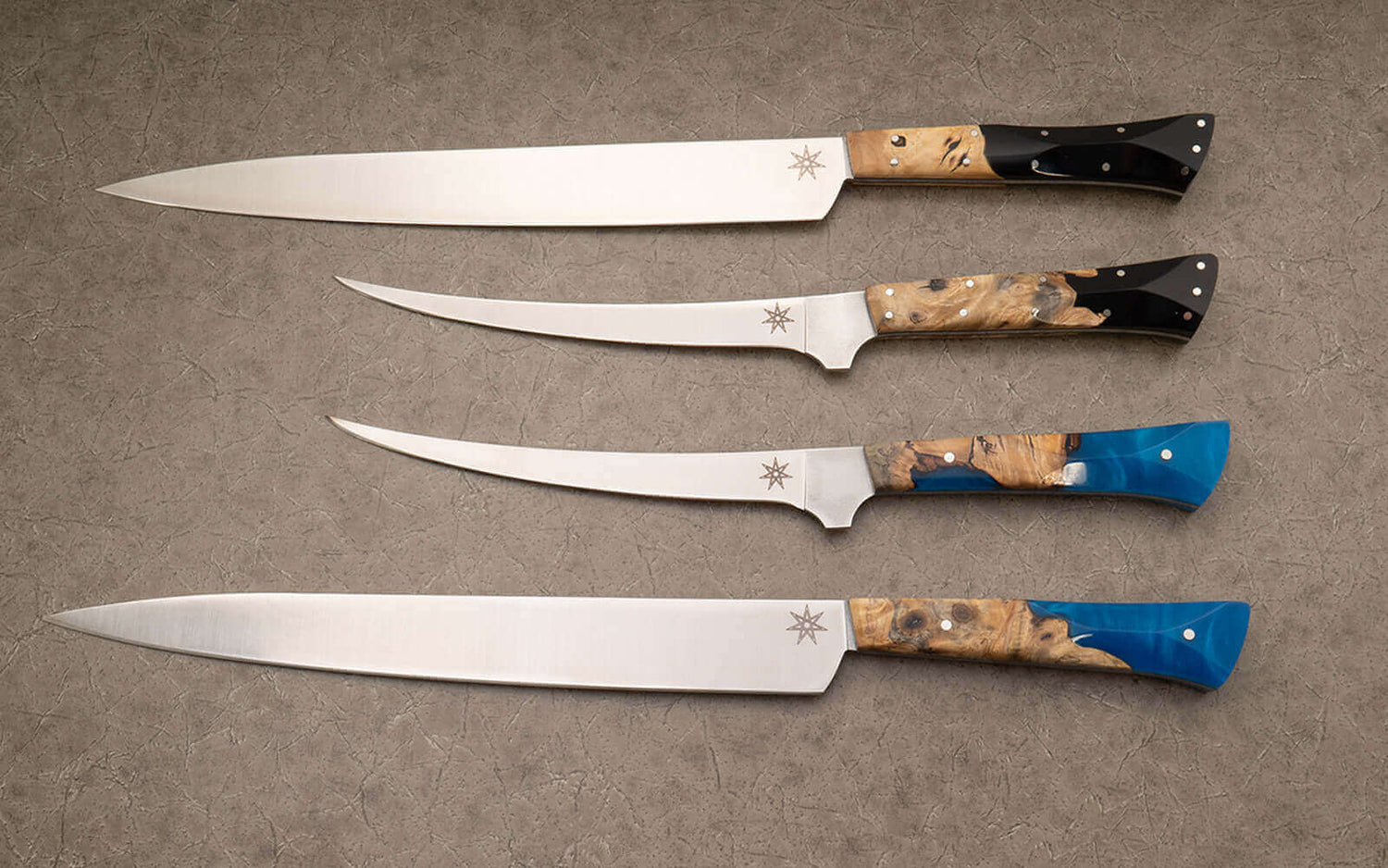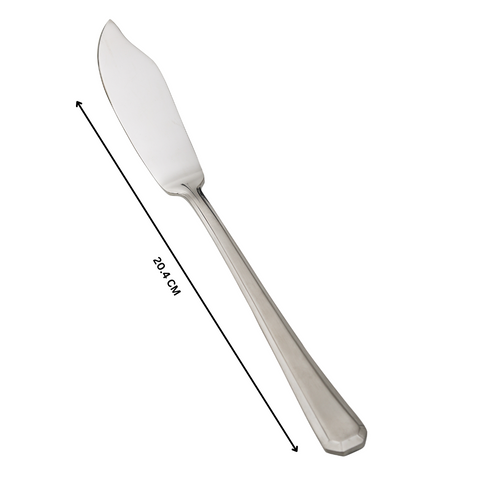The difference between a fish knife and a chef’s knife
The Ultimate Overview to Maintaining Your Fish Knife for Durability and Performance
Maintaining a fish knife is important for ensuring its long life and optimal performance. Correct care involves a series of steps, consisting of cleaning, sharpening, and storage space. Each phase adds to the knife's effectiveness throughout use. Understanding these techniques can make a significant difference in the lifespan of this important tool. Nevertheless, numerous individuals ignore vital aspects of maintenance that can lead to wear and tear. What are these often-forgotten steps?
Choosing the Right Fish Knife for Your Needs
When choosing the optimal fish knife, what secret features should one think about? The blade's flexibility is vital, permitting accuracy while filleting various fish varieties (fish knife). A thin, narrow blade typically enhances maneuverability, making it less complicated to browse around bones and skin. The material of the blade additionally plays an important duty; stainless-steel uses longevity and corrosion resistance, crucial for regular direct exposure to water
In addition, the handle's layout should not be forgotten. It needs to offer a comfy hold, ideally featuring non-slip products that guarantee safety throughout usage. The knife's size is another factor; much shorter blades can supply far better control, while longer blades may be beneficial for larger fish. Finally, weight is very important; a well-balanced knife permits expanded usage without exhaustion. By carefully taking into consideration these functions, one can pick a fish knife that fulfills certain needs for effective fish prep work.
Appropriate Cleansing Techniques After Each Use
Correct cleaning techniques after each use are crucial for maintaining the durability and efficiency of a fish knife. Immediately after filleting fish, it is important to rinse the knife under cozy water to remove scales, slime, and any type of recurring fish juices. Utilizing a soft sponge or cloth, the individual must delicately scrub the blade and handle, paying unique attention to any kind of gaps where particles might collect. Prevent using rough products that can scrape the blade's surface. After cleaning, the knife needs to be completely dried out with a tidy towel to protect against moisture-related damage. Using a food-safe mineral oil periodically can assist maintain its integrity if the knife has a wooden take care of. Storing the knife in an assigned sheath or magnetic strip can better shield it from unintended damages and guarantee it stays clean and ready for future usage. Constant adherence to these cleaning techniques will certainly improve the knife's lifespan and performance.
Developing Your Fish Knife: Tools and Techniques
Sharpening a fish knife is a critical process that boosts its performance and ensures clean cuts while filleting. To accomplish optimum sharpness, several tools can be employed. A whetstone is taken into consideration among the most reliable approaches, enabling for accurate control over the honing angle. Customers need to wet the stone and preserve a constant 20-degree angle while moving the blade across its surface.
Additionally, a developing rod can be used for regular maintenance, realigning the blade's edge without eliminating material. For benefit, electrical sharpeners offer a fast service, though they may not provide the very same level of skill as hand-operated methods.
No matter of the selected method, it is necessary to finish with a leather strop to brighten the edge, ensuring a sharp coating. Routine developing not just prolongs the life of the fish knife yet also enhances the total performance of the filleting process.
Keeping Your Fish Knife for Optimum Defense
After honing a fish knife, focus should turn to its storage space to keep the blade's stability and efficiency. Proper storage is essential for stopping rust, dulling, and damage. Ideally, a fish knife should be saved in a protective sheath or knife roll, which guards the blade from call with various other tools and ecological aspects (fish knife). Magnetic strips can additionally be reliable, allowing for accessible and secure storage space while maintaining the blade safe

Normal Maintenance Regimens to Follow
A constant maintenance routine is essential for preserving the capability and appearance of a fish knife. Normal cleaning after each use is important; washing the blade with warm water and mild soap removes any kind of deposit. It is advisable to dry the knife completely to avoid corrosion. Occasionally, a light application of food-safe mineral oil can aid protect the blade and preserve its shine.

Finally, storing the fish knife in a protective instance or sheath stops accidental damage and maintains it on-line. Adhering to these maintenance routines will significantly improve the long life and effectiveness of the fish knife.
Often Asked Concerns
Can I Utilize My Fish Knife for Various Other Kinds Of Fish?
Yes, a fish knife can be made use of for other types of fish. Nevertheless, the efficiency might differ relying on the knife's layout and the certain fish being refined, impacting efficiency and precision during preparation.
What Materials Are Best for a Fish Knife Blade?
Stainless-steel and high-carbon steel are read more considered the most effective products for a fish knife blade. Stainless-steel provides rust resistance, while high-carbon steel supplies remarkable sharpness and edge retention, important for effective fish preparation.
How Frequently Should I Replace My Fish Knife?
A fish knife need to typically be changed every 3 to five years, depending on usage and maintenance. Regular examination for indicators of wear or damages can likewise help establish the ideal time for replacement.
Are There Details Brands Recognized for Top Quality Fish Blades?
Certain brand names, like Wüsthof, Victorinox, and Rapala, are renowned for producing top quality fish blades. These brands are identified for their longevity, sharpness, and ergonomic layouts, making them preferred options among angling fanatics and experts alike.
Can Temperature Impact My Fish Knife's Performance?
Temperature level can considerably impact a fish knife's efficiency. Severe warmth may cause blade products to warp, while chilly problems can cause brittleness. Maintaining an ideal temperature level is vital for preserving the knife's capability and sturdiness.
The knife's size is another element; much shorter blades can supply better control, while longer blades may be beneficial for larger fish. Immediately after filleting fish, it is vital to wash the knife under cozy water to remove scales, slime, and any type of recurring fish juices. After developing a fish knife, focus must turn to its storage to maintain the blade's integrity and performance. Preferably, a fish knife need to be saved in a safety sheath or knife roll, which guards the blade from call with other utensils and environmental variables. Yes, a fish knife can be used for other types of fish.